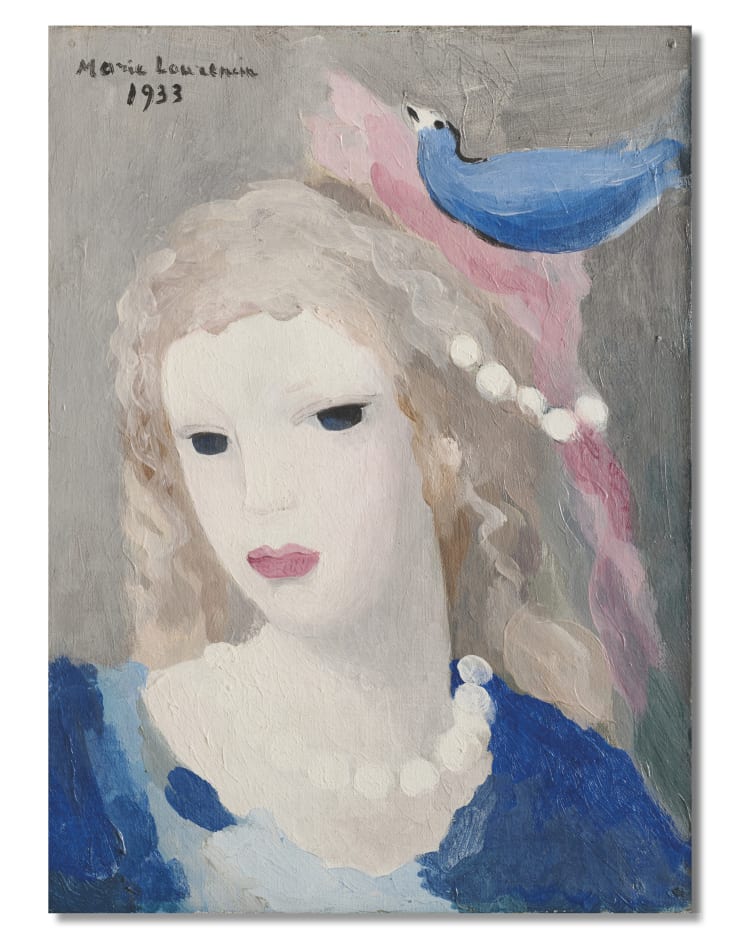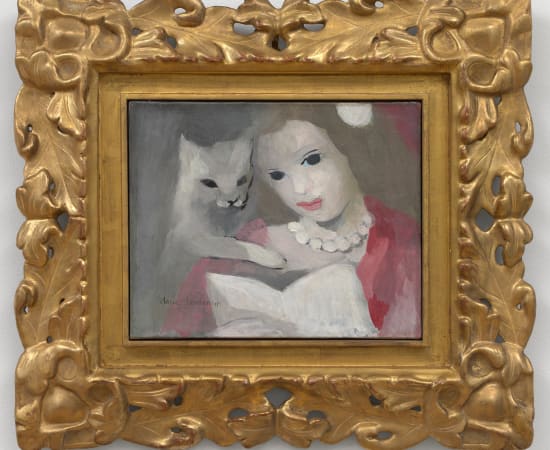Marie Laurencin (1883-1956) French
Works
Biography
Poet of Femininity, Muse of Modernism, and Painter of Dreamlike Grace
At Bailly Gallery, where we champion artists who redefined modernity through originality and lyrical vision, Marie Laurencin shines as a singular voice in 20th-century art. A leading figure of Paris’s avant-garde, Laurencin forged a path all her own—blending modernist innovation with delicate, unmistakably feminine aesthetics. Her work is at once intimate and enigmatic, a fusion of Cubist influence, poetic subtlety, and emotional nuance.
Born in Paris in 1883, Laurencin studied porcelain painting before enrolling at the Académie Humbert, where she became immersed in the dynamic circles of Montmartre and later Montparnasse. By the 1910s, she was closely associated with Pablo Picasso, Georges Braque, and especially Guillaume Apollinaire, the poet with whom she shared a significant creative and romantic relationship. She exhibited with the Salon des Indépendants and Salon d’Automne, placing her among the pioneers of Cubism, though her style remained uniquely soft and ethereal.
Laurencin’s palette—defined by pale pinks, greys, blues, and muted greens—became her signature. Her compositions, populated by graceful young women, musicians, and animals, evoke a world of private reverie and refined beauty. While modern in form, her work resists the angular severity of her male contemporaries. Instead, Laurencin created a visual language rooted in sensuality, introspection, and feminine identity—positioning her as a quiet revolutionary in a male-dominated era.
During the interwar period, Laurencin gained international acclaim, producing portraits, illustrations, ballet sets (notably for Sergei Diaghilev’s Ballets Russes), and decorative panels for private salons. Her art appealed to a generation of collectors who sought emotional resonance, intimacy, and poetic elegance amid the turbulence of modern life.
Though often underestimated in the canon of modernism, Laurencin’s importance is increasingly recognized today—not only for her contribution to Cubism’s evolution, but for her pioneering role in establishing a distinctly female gaze in modern painting. She refused to imitate masculine styles, instead cultivating her own, where softness and subtlety became strength.
Her works now reside in major collections including the Musée de l’Orangerie, the Centre Pompidou, the Musée Marmottan Monet, and the Metropolitan Museum of Art. Her legacy continues to inspire contemporary explorations of gender, identity, and lyrical abstraction.
At Bailly Gallery, we are proud to represent Marie Laurencin as a timeless voice of elegance and individuality. Her paintings are more than compositions—they are invitations into a refined inner world, where color whispers, form flows, and beauty unfolds with quiet, enduring confidence.
At Bailly Gallery, where we champion artists who redefined modernity through originality and lyrical vision, Marie Laurencin shines as a singular voice in 20th-century art. A leading figure of Paris’s avant-garde, Laurencin forged a path all her own—blending modernist innovation with delicate, unmistakably feminine aesthetics. Her work is at once intimate and enigmatic, a fusion of Cubist influence, poetic subtlety, and emotional nuance.
Born in Paris in 1883, Laurencin studied porcelain painting before enrolling at the Académie Humbert, where she became immersed in the dynamic circles of Montmartre and later Montparnasse. By the 1910s, she was closely associated with Pablo Picasso, Georges Braque, and especially Guillaume Apollinaire, the poet with whom she shared a significant creative and romantic relationship. She exhibited with the Salon des Indépendants and Salon d’Automne, placing her among the pioneers of Cubism, though her style remained uniquely soft and ethereal.
Laurencin’s palette—defined by pale pinks, greys, blues, and muted greens—became her signature. Her compositions, populated by graceful young women, musicians, and animals, evoke a world of private reverie and refined beauty. While modern in form, her work resists the angular severity of her male contemporaries. Instead, Laurencin created a visual language rooted in sensuality, introspection, and feminine identity—positioning her as a quiet revolutionary in a male-dominated era.
During the interwar period, Laurencin gained international acclaim, producing portraits, illustrations, ballet sets (notably for Sergei Diaghilev’s Ballets Russes), and decorative panels for private salons. Her art appealed to a generation of collectors who sought emotional resonance, intimacy, and poetic elegance amid the turbulence of modern life.
Though often underestimated in the canon of modernism, Laurencin’s importance is increasingly recognized today—not only for her contribution to Cubism’s evolution, but for her pioneering role in establishing a distinctly female gaze in modern painting. She refused to imitate masculine styles, instead cultivating her own, where softness and subtlety became strength.
Her works now reside in major collections including the Musée de l’Orangerie, the Centre Pompidou, the Musée Marmottan Monet, and the Metropolitan Museum of Art. Her legacy continues to inspire contemporary explorations of gender, identity, and lyrical abstraction.
At Bailly Gallery, we are proud to represent Marie Laurencin as a timeless voice of elegance and individuality. Her paintings are more than compositions—they are invitations into a refined inner world, where color whispers, form flows, and beauty unfolds with quiet, enduring confidence.
Enquire





